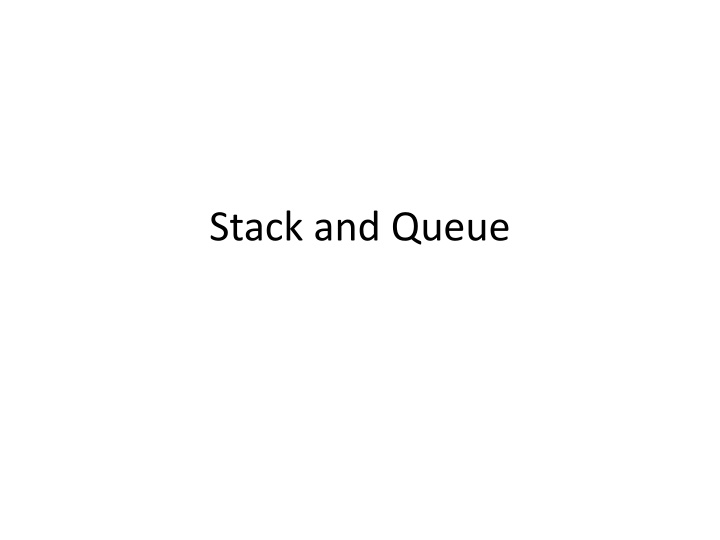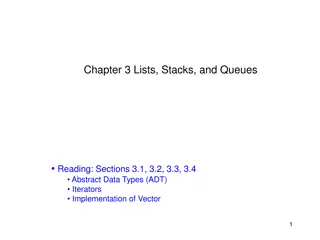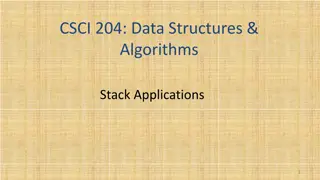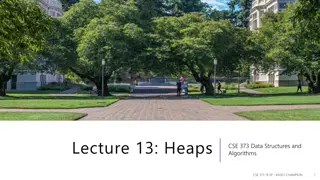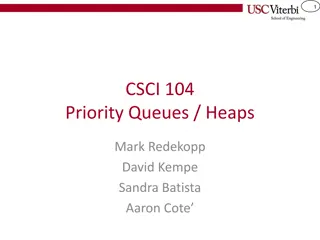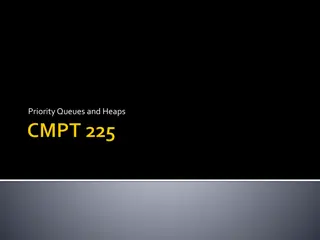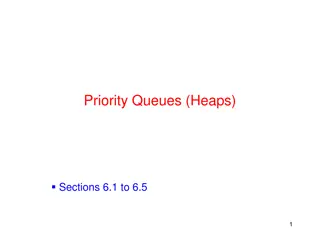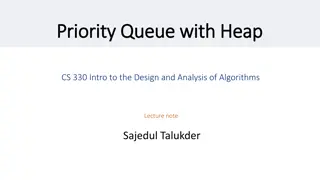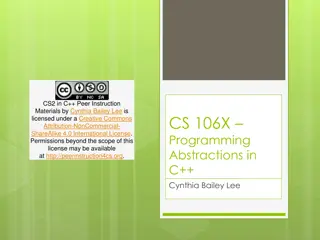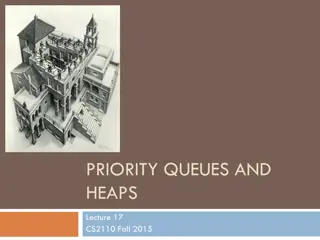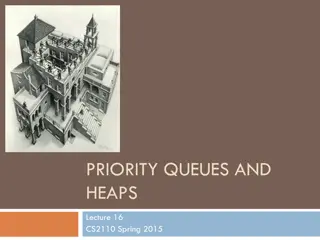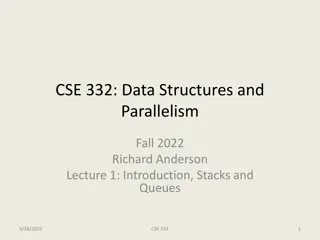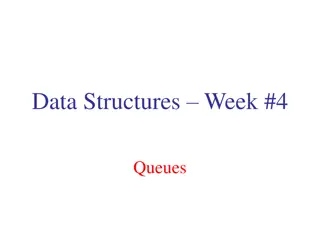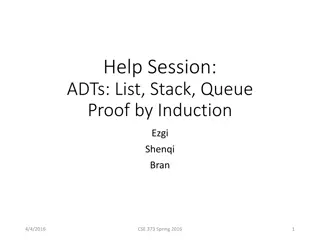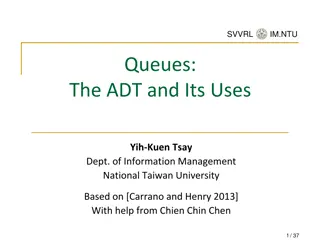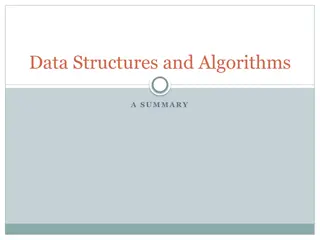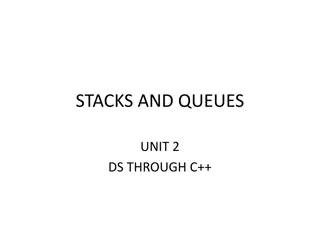Introduction to Stacks and Queues
A stack is a last-in-first-out (LIFO) data structure where items are added (pushed) and removed (popped) in a specific order. This introduction covers the definition, operations, and implementation of stacks along with linked stacks. It discusses the basic concepts and algorithms used to manage stacks efficiently.
Download Presentation

Please find below an Image/Link to download the presentation.
The content on the website is provided AS IS for your information and personal use only. It may not be sold, licensed, or shared on other websites without obtaining consent from the author.If you encounter any issues during the download, it is possible that the publisher has removed the file from their server.
You are allowed to download the files provided on this website for personal or commercial use, subject to the condition that they are used lawfully. All files are the property of their respective owners.
The content on the website is provided AS IS for your information and personal use only. It may not be sold, licensed, or shared on other websites without obtaining consent from the author.
E N D
Presentation Transcript
Introduction to Stacks A stack is a last-in-first-out (LIFO) data structure Adding an item Referred to as pushing it onto the stack Removing an item Referred to as popping it from the stack 2
A Stack Definition: An ordered collection of data items Can be accessed at only one end (the top) Operations: construct a stack (usually empty) check if it is empty Push: add an element to the top Top: retrieve the top element Pop: remove the top element 3
Selecting Storage Structure Position 0 is the bottom of the stack Our design includes: An array to hold the stack elements An integer to indicate the top of the stack 4
Implementing Operations Empty Check if value of myTop== -1 Push (if myArray not full) Increment myTop by 1 Store value in myArray[myTop] Top If stack not empty, return myArray[myTop] Pop If array not empty, decrement myTop Output routine added for testing 5
STACKS Algorithm:-1 PUSH(STACK,TOP,MAXSTK,ITEM) 1.[Stack already filled] If TOP=MAXSTK, then Write: OVERFLOW and Return [end of if structure] 2. Set TOP:=TOP+1 3. Set STACK[TOP]:=ITEM 4. Return [increases TOP by 1] [insert ITEM in new TOP position]
Algorithm:-2 POP(STACK,TOP,ITEM) 1.[Stack has an item to be removed] If TOP=0, then Write: UNDERFLOW and Return [end of if structure] 2. Set ITEM:=STACK[TOP] 3. Set TOP:=TOP-1 4. Return [Assigns TOP element to ITEM] [Decreases TOP by 1]
Linked Stacks Another alternative to allowing stacks to grow as needed Linked list stack needs only one data member Pointer myTop Nodes allocated (but not part of stack class)
Implementing Linked Stack Operations Empty Check for myTop == null Push Insertion at beginning of list Top Return data to which myTop points
Implementing Linked Stack Operations Pop Delete first node in the linked list ptr = myTop; myTop = myTop->next; delete ptr; Output Traverse the list for (ptr = myTop; ptr != 0; ptr = ptr->next) cout << ptr->data << endl; 10
Linked Representation of stack Algorithm:-3 PUSH_LINKSTACK(INFO,LINK,TOP,AVAIL,ITEM) This procedure pushes an ITEM into a linked stack 1. [Available Space?] if AVAIL=NULL , then Write: OVERFLOW and EXIT [end of if structure] 2. [Remove first node from the avail list] Set NEW:=AVAIL and AVAIL:=LINK[AVAIL] 3. Set INFO[NEW]:=ITEM 4.Set LINK[NEW]:=TOP 5.Set TOP=NEW 6.Exit [copies ITEM into new node] [new node points to the original top node in stack] [reset TOP to point to new node at the top of stack]
Algorithm:-4 POP_LINKSTACK(INFO,LINK,TOP,AVAIL,ITEM) This procedure deletes the top element an ITEM into a linked stack and assign it to the variable ITEM 1. [stack has an item to be removed?] If TOP=NULL , then Write: UNDERFLOW and EXIT [end of if structure] 2. Set ITEM:=INFO[TOP] 3. Set TEMP:=TOP and TOP=LINK[TOP] [remember the old value of the TOP pointer in TEMP and reset TOP to point to the next element in the stack] 4. Set LINK[TEMP]=AVAIL [Return deleted node to the AVAIL list] 5. Set Avail := TEMP 6. Exit [copies the top element of stack into ITEM]
QINSERT(QUEUE,N,FRONT,REAR,ITEM) This procedure inserts an element ITEM into a queue 1) [queue already filled?] If FRONT=1 and REAR=N , or if FRONT=REAR+1, then Write: OVERFLOW and return 2) [find new value of REAR] If FRONT:=NULL Set FRONT:=1 and REAR:=1 Else if REAR=N , then Set REAR:=1 Else: Set REAR:=REAR+1 [end of if structure] 3) Set QUEUE[REAR]:=ITEM 4) RETURN [then queue initially empty] [this inserts new element]
QDELETE(QUEUE,N,FRONT,REAR,ITEM) This procedure deletes an element from a queue and assign it to the variable item 1) [queue already empty?] If FRONT:=NULL Then Write: UNDERFLOW and return [end of if structure] 2) Set ITEM:=QUEUE[FRONT] 3) [find new value of FRONT] if FRONT=REAR , then: Set FRONT:=NULL and REAR:=NULL else if FRONT=N, then Set FRONT:=1 else Set FRONT:=FRONT+1 [end of if structure] 4) RETURN [queue has only one element]
LINKED REPRESENTATION[INSERT] 1. 2. Set NEW:=AVAIL and AVAIL:=LINK[AVAIL] 3. Set INFO[NEW]:=ITEM and LINK[NEW]:=NULL 4. If FRONT=NULL then FRONT=REAR=NEW else Set LINK[REAR]=NEW and REAR=NEW [end of if structure] 5. Exit If AVAIL=NULL then Write: OVERFLOW and EXIT [end of if structure]
LINKED REPRESENTATION[DELETE] 1. If FRONT=NULL then Write: UNDERFLOW and EXIT [end of if structure] 2. Set TEMP:=FRONT 3. ITEM:=INFO[TEMP] 4. FRONT:=LINK[TEMP] 5. LINK[TEMP]:=AVAIL and AVAIL:=TEMP 6. Exit
Deque (Double-ended queue) It is a linear list, where element can be added or deleted from either side. AAA BBB CCC DDD Left = 4 Right = 7 1 2 3 4 5 6 7 8 WWW YYY ZZZ XXX Left = 7 Right = 2 1 2 3 4 5 6 7 8
Priority Queue It is a collection of element such that each element has been assigned a priority, hence An element of higher priority is processed before any element of lower priority. Two elements with same priority are processed according to order in which they were added to queue.
It can be maintained in memory by means of one- way list as: Each node will contain 3 items info, priority_no & link A node X precedes a node Y in list when, X has higher priority than Y Both have same priority but X was added to list before Y
Arithmetic Expressions Arithmetic Expressions involve constants and operations. Binary operations have different levels of precedence. First : Exponentiation (^) Second: Multiplication (*) and Division (/) Third : Addition (+) and Subtraction (-)
Example Evaluate the following Arithmetic Expression: 5 ^ 2 + 3 * 5 6 * 2 / 3 + 24 / 3 + 3 First: 25 + 3 * 5 6 * 2 / 3 + 24 / 3 + 3 Second: 25 + 15 4 + 8 + 3 Third: 47
Infix Notation Infix Notation: Operator symbol is placed between the two operands. Example: (5 * 3) + 2 & 5 * (3 + 2)
Polish Notation Polish Notation: The Operator Symbol is placed before its two operands. Example: + A B, * C D, / P Q etc. In prefix notation you put the operator first followed by the things it acts on and enclose the whole lot in brackets. So for example if you want to write 3+4, in scheme you say: (+ 3 4)
Examples (A + B) * C = A + (B * C) = (A + B) / (C - D) = * + ABC + A *BC / +AB CD Also Known as Prefix Notation.
Advantage of Prefix notation The advantage of the prefix notation is that no operator precedence is required; the bracketing shows what the operator acts on. So in scheme if you want 3*4+2, you say : (+ (* 3 4) 2) And if you want 3*(4+2), you write: (* 3 (+ 4 2)) So in scheme, you don t need operator precedence, but you do need lots of brackets.
Reverse Polish Notation Reverse Polish Notation: The Operator Symbol is placed after its two operands. Example: A B+, C D*, P Q/ etc. Also known as Postfix Notation.
Postfix and Prefix Examples INFIX A + B A * B + C A * (B + C) A - (B - (C - D)) A - B - C - D POSTFIX A B + PREFIX + A B A B * C + A B C + * A B C D--- A B-C-D- + * A B C * A + B C -A-B-C D ---A B C D Prefix : Operators come before the operands 30
Advantage of Postfix notation You can easily evaluate a postfix expression in a single scan from left to right with the help of a stack (unlike evaluating infix expressions). There is no need of the concept of parentheses and precedence rules etc. in a postfix expression.
Transforming Infix into Postfix By hand: "Fully parenthesize-move-erase" method: 1. Fully parenthesize the expression. 2. Replace each right parenthesis by the corresponding operator. 3. Erase all left parentheses. Examples: A * (B + C) (A (B C + * A B C + * (A * (B + C) ) A * B + C ((A B * C + A B * C + ((A * B) + C) 32
Infix to Postfix A + ( B * C ( D / E F ) * G ) * H Symbol Scanned Stack Expression P A ( A + ( + A ( ( + ( A B ( + ( A B * ( + ( * A B C ( + ( * A B C - ( + ( - A B C * ( ( + ( - ( A B C * D ( + ( - ( A B C * D / ( + ( - ( / A B C * D E ( + ( - ( / A B C * D E ( + ( - ( / A B C * D E
A + ( B * C ( D / E F ) * G ) * H Symbol Scanned Stack Expression P F ( + ( - ( / A B C * D E F ) ( + ( - A B C * D E F / * ( + ( - * A B C * D E F / G ( + ( - * A B C * D E F / G ) ( + A B C * D E F / G * - * ( + * A B C * D E F / G * - H ( + * A B C * D E F / G * - H ) A B C * D E F / G * - H * +
Infix to Postfix Transformation (Algo.) POLISH (Q, P) 1. PUSH ( on to STACK and add ) to the end of Q. 2. Scan Q from left to right and Repeat steps 3 to 6 for each element of Q until the STACK is empty: 3. If an operand is encountered, add it to P. 4. If a left parenthesis is encountered, push it onto STACK. 5. If an operator is encountered, then: (a) Repeatedly POP from STACK and add to P each operator (On the TOP of STACK) which has the same precedence as or higher precedence than @. (b) Add @ to STACK. [End of If structure.] 6. If a right parenthesis is encountered, then: (a) Repeatedly POP from STACK and add to P each operator (On the TOP of STACK.) until a left parenthesis is encountered. (b) Remove the left parenthesis. [Don t add the left parenthesis to P.] [End of If Structure.] [End of step 2 Loop.] 7. Exit.
Evaluating Postfix (RPN) Expressions "By hand" (Underlining technique): 1. Scan the expression from left to right to find an operator. 2. Locate ("underline") the last two preceding operands and combine them using this operator. 3. Repeat until the end of the expression is reached. Example: 2 3 4 + 5 6 - - * 2 3 4 + 5 6 - - * 2 7 5 6 - - * 2 7 5 6 - - * 2 7 -1 - * 2 7 -1 - * 2 8 * 2 8 * 16 36
Evaluation of Postfix (RPN) Expression (Algo.) P is an arithmetic expression in Postfix Notation. 1. Add a right parenthesis ) at the end of P. 2. Scan P from left to right and Repeat Step 3 and 4 for each element of P until the sentinel ) is encountered. 3. 4. If an operand is encountered, put it on STACK. If an operator @ is encountered, then: (a) Remove the two top elements of STACK, where A is the top element and B is the next to top element. (b) Evaluate B @ A. (c) Place the result of (B) back on STACK. [End of if structure.] [End of step 2 Loop.] Set VALUE equal to the top element on STACK. Exit. 5. 6.
Evaluating RPN Expressions
Quick Sort It is an algorithm of divide and conquer. 44, 33, 11, 55, 77, 90, 40, 60, 99, 22, 88, 66 After reduction step, final position of no. is: 22, 33, 11, 40, 44, 90, 77, 60, 99, 55, 88, 66 First sublist Second sublist
The algorithm begins by pushing boundary values 1 and 12 onto stack to yield Lower: 1 Upper: 12 To apply reduction step, top values are removed from stack, leaving Lower: (empty) Upper: (empty) And then reduction step is applied to list from A[1] to A[12]. Finally 44 reaches its final location A[5]. Accordingly, algo. Pushes boundary values 1 and 4 to 1st sublist and 6 and 12 to 2nd sublist onto stack, leaving Lower: 1, 6 Upper: 4, 12 Now, apply reduction step again by removing top values from stack, leaving Lower: 1 Upper: 4 Then reduction step is applied to sublist A[6] to A[12], and so on. Lower: 1, 6 Upper: 4, 10
Quick sort algorithm QUICK(A, N, BEG, END, LOC) 1. [Initialize] Set LEFT = BEG, RIGHT=END, LOC=BEG 2. [Scan from right to left] a. Repeat while A[LOC] <=A[RIGHT] and LOC != RIGHT i. RIGHT = RIGHT-1 b. If LOC = RIGHT then return c. If A[LOC] > A[RIGHT] then i. [Interchange A[LOC] and A[RIGHT] ] Temp = A[LOC], A[LOC] = A[RIGHT], A[RIGHT] = Temp ii. Set LOC = RIGHT iii. Go to step 3. 3. [Scan from left to right] a. Repeat while A[LEFT] <=A[LOC] and LEFT != LOC i. LEFT = LEFT+1 b. If LOC = LEFT then return c. If A[LEFT] > A[LOC] then i. [Interchange A[LEFT] and A[LOC] ] Temp = A[LOC], A[LOC] = A[LEFT], A[LEFT] = Temp ii. Set LOC = LEFT iii. Go to step 2.
Quick sort algorithm QUICKSORT() 1. [Initialize] TOP = NULL 2. [Push boundary value of A onto stacks when A has 2 or more elements] If N >1 then TOP = TOP + 1, LOWER[1] = 1, UPPER[1] = N 3. Repeat steps 4 to 7 while TOP != NULL 4. [Pop sublist from stacks] Set BEG = LOWER[TOP] , END = UPPER[TOP] TOP = TOP 1 5. Call QUICK(A, N, BEG, END, LOC) 6. [ Push left sublist onto stacks when it has 2 or more elements] If BEG < LOC-1 then TOP = TOP + 1, LOWER[TOP] = BEG, UPPER[TOP] = LOC-1 7. [ Push right sublist onto stacks when it has 2 or more elements] If LOC+1 < END then TOP = TOP+1, LOWER[TOP] = LOC + 1, UPPER[TOP] = END 8. Exit.
Complexity of Quick Sort Worst case O(n2) Average case O(n log n)
Algorithm Tower (N, Beg, Aux, End) 1. If N = 1, then a) b) Write Beg End Return 2. // [Move N-1 disks from Beg to Aux] Call Tower (N-1, Beg, End, Aux) Write Beg End 3. 4. // [Move N-1 disks from Aux to End] Call Tower (N-1, Aux, Beg, End) 7. Return
